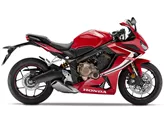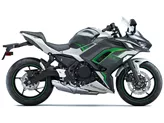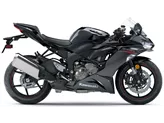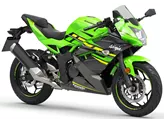Suzuki GSX-R 750 2015 vs. Kawasaki Ninja 650 2017

Suzuki GSX-R 750 2015

Kawasaki Ninja 650 2017
Overview - Suzuki GSX-R 750 2015 vs Kawasaki Ninja 650 2017
The Suzuki GSX-R 750 2015 and the Kawasaki Ninja 650 2017 are both popular models in the supersport category, but they have some notable differences in terms of technical specifications and strengths.
Starting with the engine, the Suzuki GSX-R 750 2015 is equipped with a 749cc in-line four-cylinder engine, producing a powerful 150 horsepower and 86.3 Nm of torque. On the other hand, the Kawasaki Ninja 650 2017 features a smaller 649cc in-line twin-cylinder engine, delivering 68.2 horsepower and 65.7 Nm of torque. While the Suzuki GSX-R 750 offers more power, the Kawasaki Ninja 650 compensates with a more resilient engine.
In terms of chassis and frame, the Suzuki GSX-R 750 2015 features an aluminum twin-spar frame, providing excellent stability and control. On the other hand, the Kawasaki Ninja 650 2017 comes with a steel tubular frame, offering a transparent chassis for sporty handling. Both frames contribute to the overall performance and handling of the motorcycles.
When it comes to brakes, both models are equipped with double disc brakes at the front. The Suzuki GSX-R 750 2015 has excellent brakes, providing strong and reliable stopping power. The Kawasaki Ninja 650 2017 also offers excellent brakes, ensuring efficient braking performance.

Suzuki GSX-R 750 2015
In terms of suspension, the Suzuki GSX-R 750 2015 offers adjustable compression, preload, and rebound at the rear, allowing riders to fine-tune their suspension settings. On the other hand, the Kawasaki Ninja 650 2017 only offers preload adjustment at the rear suspension.
In terms of dimensions and weights, both motorcycles have a front tire width of 120 mm and a front tire diameter of 17 inches. However, the Suzuki GSX-R 750 2015 has a wider rear tire width of 180 mm compared to the Kawasaki Ninja 650 2017's 160 mm. The wheelbase of the Suzuki GSX-R 750 is slightly shorter at 1400 mm, while the Kawasaki Ninja 650 has a wheelbase of 1410 mm. The seat height of the Suzuki GSX-R 750 is 810 mm, slightly higher than the Kawasaki Ninja 650's 790 mm. Additionally, the Suzuki GSX-R 750 has a larger fuel tank capacity of 17 liters compared to the Kawasaki Ninja 650's 15 liters.
In terms of strengths, the Suzuki GSX-R 750 2015 offers excellent engine response and great controllability. It also provides a comfortable seating position, even for tall riders. The reliable technology and perfect transmission of the Suzuki GSX-R 750 contribute to its overall appeal.

Kawasaki Ninja 650 2017
On the other hand, the Kawasaki Ninja 650 2017 has a transparent chassis for sporty handling and offers a playful and good-natured riding experience. It also boasts excellent brakes and sharp looks inspired by the ZX-10R model.
However, both motorcycles have their weaknesses. The Suzuki GSX-R 750 2015 may be considered unspectacular at the regulars' table and its brake pads and lines may not be suitable for racetrack use. Additionally, it has a long final gear ratio, which may affect its performance in certain situations.
On the other hand, the Kawasaki Ninja 650 2017 has a relatively quiet sound from the stock exhaust and may exhibit slight vibrations from its engine.
In conclusion, the Suzuki GSX-R 750 2015 and the Kawasaki Ninja 650 2017 are both capable motorcycles in the supersport category. The Suzuki GSX-R 750 offers more power and a wider range of adjustability, while the Kawasaki Ninja 650 compensates with a resilient engine and sporty handling. Ultimately, the choice between the two models will depend on the rider's preferences and priorities.
Technical Specifications Suzuki GSX-R 750 2015 compared to Kawasaki Ninja 650 2017
Pros and Cons in comparison
Pros and Cons in comparison
Suzuki GSX-R 750 2015

The GSX-R 750 is the golden mean in many respects. It offers a level of performance that doesn't overwhelm you on the road, but at the same time gives you a lot of pleasure. On the one hand, it is relatively inexpensive, but on the other hand, it is still fast enough. The GSX-R 750 is a great supersport machine. If you don't value superlatives and just want a good motorbike, go for the GSX-R 750 and use the money you save to treat yourself to race training on the Nordschleife....
Kawasaki Ninja 650 2017

The Ninja 650 firmly stamps its predecessor (Er-6f). The engine has mastered the Euro 4 hurdle well and serves up a very usable 68 hp, the chassis is simply great for this class, and the weight reduction of 18(!) kilos compared to the ER-6f justifies reverent nods.
Price Comparison Avarage Market Price Suzuki GSX-R 750 vs Kawasaki Ninja 650
There are a few key differences between a Suzuki GSX-R 750 2015 and a Kawasaki Ninja 650 2017. It takes less time to sell a Suzuki GSX-R 750 with 95 days compared to 96 days for a Kawasaki Ninja 650. Since model year 2005 1000PS.de editors have written 30 reviews for the Suzuki GSX-R 750 and 20 reviews for the Kawasaki Ninja 650 since model year 2017. The first review for the Suzuki GSX-R 750 was published on 9/16/2003 and now has more than 4,000 views. This compares to more than 79,600 views for the first review on Kawasaki Ninja 650 published on 10/4/2016.






























